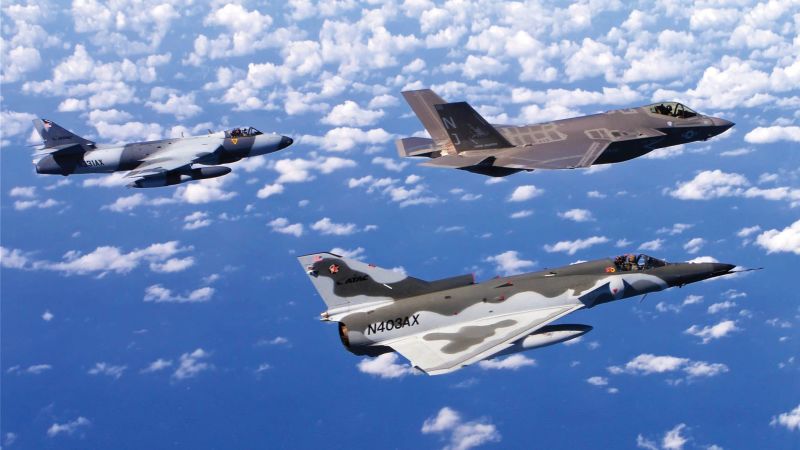
 Foxtrot AlphaTech and news from the world of modern defense.
Foxtrot AlphaTech and news from the world of modern defense.If you had to guess which state contains a private air force, you would guess Texas. You just would. Airborne Tactical Advantage, located near Fort Worth, Texas, has an inventory of more than 90 fighter and attack jets, contracting them to the U.S. military to role play as aggressor aircraft—including the U.S. Navy’s world famous TOP GUN program.
Airborne Tactical Advantage is a subsidiary of U.S. defense contracting giant and/or Cessna parent company Textron, and the company’s rise is part of a broader rise of Private Military Contractors (PMCs, a number of which, such as the infamous Blackwater, are more commonly known as “mercenaries”) worldwide, and the military’s increasing reliance on PMCs for aviation training.
Advertisement
What does a private company with fighter jets do with them? Contract out to the U.S. military for training, mostly. ATAC pairs fighter jets with retired military pilots and offers them to the Pentagon to to provide Dissimilar Aircraft Combat Training, or DACT. DACT allows a squadron of U.S. Navy Super Hornets, for example, to training against aircraft that aren’t other Super Hornets, increasing pilot experience flying against other types of airplanes. The jets are also used by the U.S. Navy to simulate incoming missiles, especially the low-flying anti-ship kind, training ship crews to track and identify real-world targets—just without the shooting them down part.
ATAC jets participate in the U.S. Air Force’s Red Flag multinational exercises, providing simulated adversaries. The company says its aircraft flew 100 hours in support of the 2018 Rim of the Pacific exercises in Hawaii, and also contributes fighter jets to the TOP GUN program. Jester, the adversary pilot in the Top Gun movie played by Michael Ironside, might very well today be a private contractor and not an active duty U.S. Navy pilot.
Of course, the U.S. military has its own fighters that are supposed to provide simulated aggressor aircraft. The problem is there are too few of them. The Air Force has just two aggressor squadrons, with one each based in California and Alaska, the Marine Corps one squadron, and the U.S. Navy three squadrons plus aircraft flying as part of TOP GUN. Six squadrons, however, is just not enough to support the thousands of tactical aircraft in the entire U.S. military machine.
Advertisement
In July 2017, ATAC signed perhaps the largest government-to-private fighter jet transfer in history. The company purchased 63 Dassault Mirage F1 fighter jets from the French Air Force, and the deal, worth $23.6 million dollars, involved 63 jets and 150 engines—enough to keep these planes flying for a good long time. Textron upgraded 45 of the Mirages with “modern avionics systems such as digital radio-frequency memory-jamming capabilities and upgraded radars,” according to Jane’s.

Designed by France’s Dassault Aviation, the Mirage F1 was first introduced into French Air Force service in 1973. The fighter was designed to fly a broad set of missions, including air-to-air and air-to-ground combat missions. It could fly at speeds exceeding Mach 2 while landing at just 125 knots, thanks to a high, wide wing configuration that generates a great deal of lift. The single engine Mirage F1 is powered by the Snecma Atar 9K50 afterburning turbofan engine that produces 15,736 pounds of thrust.
Advertisement
ATAC has about 90 fighter jets, according to its web site, and the company already operates Israeli-made F-21 Kfir jets (a derivative of an earlier model Dassault fighter, the Mirage III), UK-made Mk. 58 Hawker Hunter jets, and the Cold War-era Czechoslovakian L-39 Albatross jet trainer. One of the company’s Hawker Hunters crashed off the coast of Oahu, Hawaii in 2018. It’s not clear how many jets the company has now that the F1 purchase has been completed.
But here’s a company promotional video from 2016 that shows many of the planes in ATAC’s inventory, as well as the planes in military service they fly against:
Hiring private contractors is also cheaper than having the latest and greatest fighters sparring against one another. Modern fighter are expensive to fly, often costing more to fly over their lifetime than the cost of the aircraft themselves. The Navy’s Super Hornet cost $15,000 per flight hour and the F-35 Joint Strike fighter costs a pricey $35,000 an hour. It’s not clear how much an ATAC F-1 costs to fly per hour, but it’s cheap enough the company thinks there’s a profit to be had. From the military’s perspective jets like the F1 aren’t capable of the same maneuvers as, for example, the Russian Su-35 Flanker-E but are can still give military pilots valuable flying experience.
Advertisement
Theoretically, anyone with the money create his or her air force and hire it out to the Pentagon, but the startup costs—of lining up planes, pilots, and maintainers, not to mention boring stuff like an accounting department and an HR department, is large.
Another factor, as this article at the U.S. Naval Institute notes, training support contracts are limited to five years, making it easier for larger companies with deep pockets to sustain them. The fun may be there, but the business entails smaller margins.















